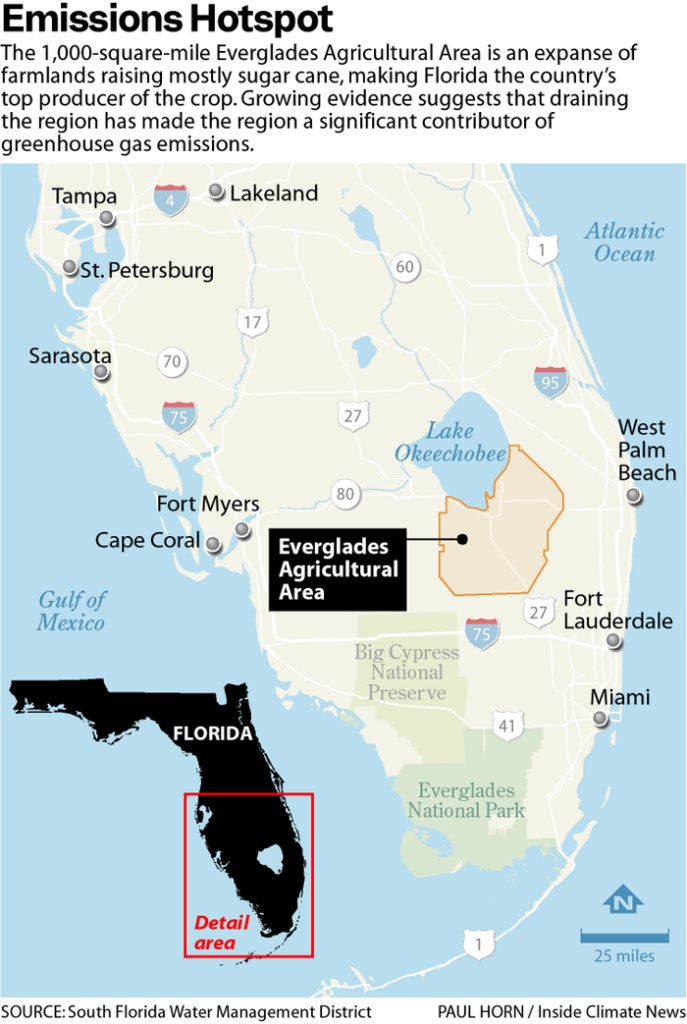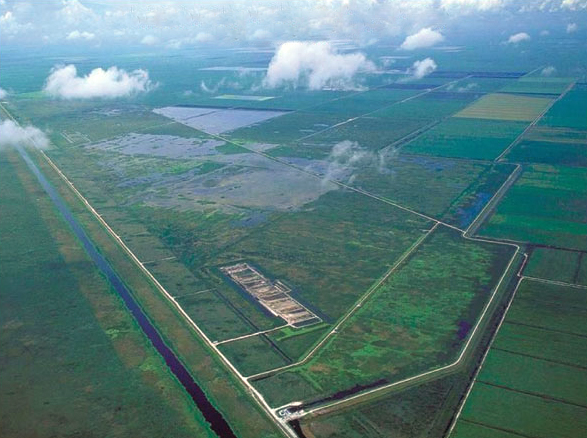This article originally appeared on Inside Climate News, a nonprofit, independent news organization that covers climate, energy and the environment. It is republished with permission. Sign up for their newsletter here.
By Amy Green, Inside Climate News
ORLANDO, Fla. — It used to be the water spilled over Lake Okeechobee’s southern shore, flowing eventually into the sawgrass prairies of the Florida Everglades. For thousands of years the marsh vegetation flourished and died here in an endless cycle, the plant remains falling beneath the slow-coursing water to form a rich layer of organic soil called peat.
Over time the fertile soil, along with the subtropical climate and abundance of water, drew the attention of farmers, who as far back as the 1880s began digging canals to drain away the water and expose the peat for planting.
Today this region, known as the Everglades Agricultural Area, is among the nation’s most bountiful, raising rice, sod, vegetables like lettuce, celery and corn and most notably sugar cane, making Florida the country’s top producer of the crop.
Growing evidence suggests that draining the water and exposing the peat also has made the region a significant source of greenhouse gas emissions, which are warming the global climate and contributing to impacts like hotter temperatures, rising seas and more damaging hurricanes.
The Everglades represent Florida’s most important freshwater resource. The watershed spans much of the peninsula, encompassing the Kissimmee River, Lake Okeechobee, sawgrass prairies to the south and Florida Bay. Various efforts over the last century to drain the Everglades, the largest steered by the U.S. Army Corps of Engineers, have made modern Florida possible and left the river of grass drastically altered. A $21 billion federal and state effort to restore the Everglades is among the most ambitious of its kind in human history.
The Everglades Agricultural Area hugs the southern shore of Lake Okeechobee, the state’s largest lake. Emissions here especially are a concern because, although vast swaths throughout the watershed have been drained, this region historically harbored the greatest deposits of peat, said Meenakshi Chabba, ecosystem and resilience scientist at the Everglades Foundation, an advocacy group that commissioned one recent study on the emissions.

“This is one little spot nestled in a highly conserved area that is really a global emissions hotspot,” she said. “Right here is the Everglades Agricultural Area, which is bleeding greenhouse gas emissions and leading to global heating.”
The study, conducted by Winrock International, a nonprofit focused on social, agricultural and environmental issues, found that sugar cane production in the Everglades Agricultural Area accounted for more than 7.3 million metric tons of greenhouse gas emissions annually, an amount equivalent to that from 1.6 million gas-powered passenger vehicles driven for one year. The scope of the emissions would place the region among the top 100 greenhouse gas polluters in the U.S., in a league with the likes of Nebraska Public Power District (7.6 million metric tons) and East Kentucky Power Cooperative (7.3 million metric tons), which are 82nd and 83rd on the list, said Steve Davis, chief science officer at the Everglades Foundation.
The vast majority of the agricultural area’s emissions, 84%, were a result of drainage leading to peat oxidation and loss, according to the study. The researchers also examined emissions related to agricultural equipment (3.8%), pre-harvest field burning (1.7%), drainage canals (1%), pesticides (0.7%) and fertilizers (0.6%), among other sources. Emissions associated with the processing of sugar cane were excluded because the region’s mills and refineries are powered through the combustion of sugar cane by-products, the study said.
Florida’s largest sugar growers characterized the study as inaccurate and based on faulty data and analysis. U.S. Sugar, responsible for nearly 10% of all the sugar produced in the U.S., pointed out the region plays an important part in providing the nation’s food and that cane is a crop that absorbs carbon. Florida Crystals Corp., another leading producer of sugar cane, said its farmers have taken steps to minimize peat loss and greenhouse gas emissions by focusing, for instance, on minimizing soil disturbance and keeping soils covered.
Florida Crystals also said it rotates sugar cane with rice and vegetables to naturally replenish soils and promote biodiversity. Soils that are recovered after milling are mixed with other byproducts and composted to generate organic fertilizer. The company said more than 80% of its operations are powered with renewable energy.
Meanwhile, a separate study estimated that at least 1.3 billion metric tons of carbon dioxide have been released from the Everglades watershed since 1880 as a result of peat loss, an amount equivalent to one-quarter of all carbon dioxide emissions in the United States in 2015. Nearly 68% of the emissions were from the Everglades Agricultural Area. The study involved researchers from multiple organizations, including the South Florida Water Management District, the state agency overseeing Everglades restoration.
Regarding the Winrock study, Betsey Boughton, program director of agroecology and senior research biologist at Archbold Biological Station, a nonprofit research, conservation and education organization, said: “The results were in line with previous studies on the area.”
Peat is composed of plant remains that accumulate over time, with decomposition limited by inundation. In some places of the Everglades the organic soils are more than 10 feet deep. The plant remains have left the soils rich with carbon, although as drainage exposes the soils to oxygen the organic material can break down, releasing the carbon into the atmosphere.
The process also can lead to land loss or subsidence. The land loses elevation as the peat emits carbon. In the Everglades Agricultural Area as much as 69% of the peat volume has been lost, and in some places more than nine feet of the elevation is gone, according to the Winrock study, forcing the need to prop up some structures on stilts. Peat oxidation also can lead to fire, causing the rapid release of carbon. The network of canals that today serve to manage water levels in this region has also become a source of methane emissions.

Sugar farmers long have played a complicated role in Everglades restoration, since the federal government sued the state in the late 1980s over the farmers’ water pollution, which was threatening protected areas of the fragile watershed.
Since then the state has put $1.8 billion toward improving water quality, including constructing vast engineered wetlands south of the Everglades Agricultural Area aimed for the most part at the farmers’ pollution. The engineered wetlands are the largest of their kind in the world.
For their part, the farmers have adopted so-called best management practices that include things like altering fertilizer techniques, controlling soil erosion and increasing onsite water retention. Together the efforts have decreased the water pollution at a rate that is more than double that mandated by state law, according to the South Florida Water Management District. Today at least 90% of the Everglades’ water meets standards, although some environmental groups argue the politically powerful farmers have not paid their fair share toward the cleanup.
Sugar farmers say they are taking other steps to address peat loss. Rick Roth, an independent midsized farmer raising sugar cane, vegetables and rice, said he minimizes peat loss by rotating crops and keeping the soils flooded as much as possible. He said he would be open to additional best management practices, but would have doubts about practices aimed at greenhouse gas emissions. He is concerned as a farmer about climate change. For instance, Hurricane Ian in September 2022 slowed his planting, but he does not believe the emissions are responsible for the warming.
“I don’t think people are worried about greenhouse gas emissions from peat loss. I don’t see greenhouse gas emissions as being a significant problem,” said Roth, a Republican who also serves in the state Legislature. “It’s not that simple.”
The efforts can help with the peat loss but will not be enough to stop it, said Paul Gray, science coordinator for Audubon Florida’s Everglades program. Raising sugar cane in the Everglades Agricultural Area requires that the water table be lowered to a point where the soils inevitably will be dry, and that will lead to oxidation, he said. He noted a welcome sign in the farming town of Belle Glade that reads, “Her Soil Is Her Fortune.”
“Her fortune is oxidizing away,” said Gray, who has worked in the region for 35 years. “Short of the state telling sugar farmers they can’t grow sugar anymore there’s not much you can do. If sugar is the crop that you’re going to grow you’re just going to have oxidation because you have to dry out the soil enough to start oxidation, and there is really no way around it.”
Beyond such issues related to the peat, climate change is poised to have a big impact on the Everglades writ large. Rising temperatures will increase evaporation, stressing a watershed responsible for the drinking water of some 9 million Floridians and already pressured by explosive population growth. The hotter temperatures also will lead to precipitation changes, raising concerns about whether the water management infrastructure here, some of the most complex in the world, is up to future challenges.
One preliminary study concluded that climate change increased Hurricane Ian’s rainfall rates by more than 10%, according to researchers at Stony Brook University and the Lawrence Berkeley National Laboratory. Ian was responsible for $113 billion in damage and 156 deaths, making it the costliest hurricane in state history and third-costliest on record in the United States, after Katrina in 2005 and Harvey in 2017.

Meanwhile, the Everglades watershed is situated on relatively flat, low-lying and porous terrain. Sea-level rise will push saltwater into the vast network of canals here, transforming habitat. Farther south of the Everglades Agricultural Area, saltwater intrusion in Everglades National Park is forcing the collapse of peat in freshwater marshes. The collapsed areas look something like large puddles surrounded by marsh vegetation, representing another form of land loss.
Everglades restoration should help stem the peat loss and greenhouse gas emissions by maintaining more water on the landscape that today is drained out to sea. The effort involves an array of landscape-scale projects that together are aimed at reviving the river of grass’ historic flow. This should encourage new peat accumulation and carbon sequestration, according to yet another study by the South Florida Water Management District.
Government programs targeting peat loss and greenhouse gas emissions in regions like the Everglades Agricultural Area may be coming, said Boughton of the Archbold Biological Station. The Inflation Reduction Act included $19.5 billion for climate smart agriculture. Sugar farmers also could, for instance, avoid pre-harvest burning, said Fred Sklar, director of the South Florida Water Management District’s Everglades Systems Assessment Section. The farmers burn the fields to clear them of vegetative debris in advance of mechanic harvesters, which cut the cane.
“All of us are trying to figure out how can we cut down on our emissions. It’s not just agriculture. We need to look at whether the hydrology of the Everglades is influencing its emissions as well,” he said. “We are making a significant increase in the volumes of water going into the Everglades, and our change in hydrology is reducing emissions.”
Amy Green covers the environment and climate change from Orlando, Florida. She is a mid-career journalist and author whose extensive reporting on the Everglades is featured in the book “Moving Water,” published by Johns Hopkins University Press, and podcast “Drained,” available wherever you get your podcasts. Amy’s work has been recognized with many awards, including a prestigious Edward R. Murrow Award and Public Media Journalists Association award.
This story was produced in partnership with the Florida Climate Reporting Network, a multi-newsroom initiative founded by the Miami Herald, the South Florida Sun Sentinel, The Palm Beach Post, the Orlando Sentinel, WLRN Public Media and the Tampa Bay Times.
Sign up for The Invading Sea newsletter by visiting here. If you are interested in submitting an opinion piece to The Invading Sea, email Editor Nathan Crabbe at ncrabbe@fau.edu.



